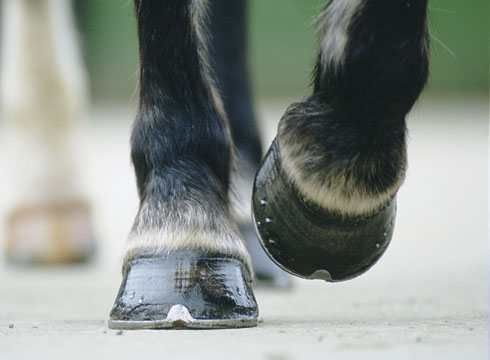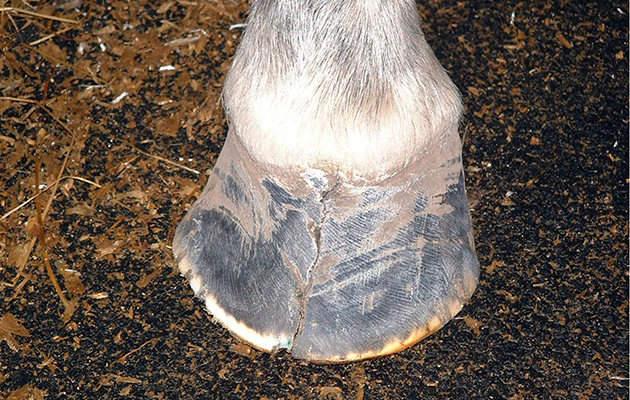Hoof cracks in the wall of the horse’s foot can range from being little more than a cosmetic blemish to a serious cause of lameness and pain. They can run vertically or horizontally, when they appear parallel to the coronary band.
A vertical crack that begins at the coronary band is called a sand crack, whereas one that appears to originate from bottom of the hoof wall is known as a grass crack.
To understand the significance of hoof cracks, it helps to know how the hoof wall grows and the way it is structured.
Hoof cracks in horses: Structure | Causes | Treatment | Prevention
The hoof wall
The hoof wall grows downwards from the coronary band, originating from “germinative epithelial” cells at the coronet. It takes between 10 and 12 months for new hoof wall to grow from the coronary band to where the sole meets the ground (the “solar surface”). At the heel, the process takes around three months.
The hoof wall has three layers. A fine outer layer, called the perioplic horn (also known as the stratum externum), encloses the tubular horny layer that forms the substantial part of the hoof wall (the stratum medium). Beneath this tough outer layer are the laminae (the stratum internum), vital structures that interweave with the sensitive laminae to hold the pedal bone in position.The colour of the hoof wall is determined by the colour of the skin at the coronary band; pink skin means white horn, coloured skin means brown horn. But there is no scientific evidence to support the belief that white hooves are softer than pigmented hooves.A crack that penetrates the tubular horn into the laminal layer below is described as full thickness and will usually cause pain, bleeding and lameness.
Common causes of hoof cracks
Vertical cracks can develop for a variety of reasons. Poor hoof quality is a common cause and environmental conditions can also play a part, with extreme dryness a frequent cause for grass cracks to appear.
Grass cracks may develop where shoeing is infrequent and the feet are too long, or because of chronic lateromedial (side-to-side) imbalance. The poor positioning of horse shoe clips or nails can make vertical cracks worse.
An abscess that disrupts the coronary corium (layer) can result in a sand crack at the coronary band, whereas conditions such as seedy toe and keratoma can lead to cracking at the solar surface.
Any direct trauma to the coronary band or hoof wall can cause a sand crack or a grass crack, depending on where the damage is.
Injuries or lacerations to the coronary band can disrupt the intricate configuration of new horn growth, resulting in permanent vertical cracks that never disappear.
Vertical cracks may make shoeing difficult and can create instability of the hoof capsule, leading to lameness. The formation of hoof abscesses is a common secondary problem, as dirt or bacteria can become trapped in the crack and subsequently forced upwards into the sensitive tissues.
Horizontal cracks typically occur due to direct trauma to the outer hoof wall, or damage to the coronary band that results in a temporary cessation of the growth of the laminar wall. An abscess that breaks out at the coronary band will also disrupt normal growth patterns, causing a crack.
Most horizontal cracks are harmless. But in certain cases, grit or foreign material can invade the white line (the inter-connected lamina between the sole and hoof wall), or the inner, sensitive tissue, causing an abscess. Horizontal cracks can also make nail placement difficult during shoeing.
Substantial horizontal defects may cause instability in the hoof capsule and consequent lameness due to abnormal rotation of the structures within the foot.
For example, a large horizontal quarter crack, in the back third of the hoof, can mean loss of heel contact with the shoe, requiring the use of a special shoe, such as a heart- or straight-bar. But the long-term prognosis for these horizontal cracks is excellent, as they will eventually grow out.
Treatment for hoof cracks
Less is generally more when it comes to managing hoof cracks. The majority need only good foot balance and a well-fitted shoe.
Where treatment is required, this relies on three concepts: debriding (cleaning away) dead tissue; establishing good foot balance to ensure a level footfall; and stabilisation of the crack, either with a special shoe or some other means, such as a hoof cast.
There are many complicated methods of repairing hoof cracks, all of which have a role. These range from fibreglass patches to wiring the two sides of the crack together, or using an orthopaedic bone plate to bridge the gap.
Preventing hoof cracks
One of the most common causes of cracks is also the simplest to avoid. Overlong intervals between shoeing sessions are a big risk — and being unshod doubles the chances of a horse developing a foot abscess.
Arrange regular shoeing — every six weeks, at least — or, in the case of the barefoot horse, organise a trim every four weeks.
If your farrier or vet feels your horse’s hooves would benefit from additional nutritional support, a good hoof supplement containing biotin, often with zinc and methionine can encourage healthy hoof growth, but it needs to be fed for several months before seeing the benefit, and may be required on an on-going basis for maintenance.
There are a wide range of hoof lotions, oils and balms on sale designed to maintain the ideal levels of moisture in the horse’s hoof – and your farrier may also suggest these – although there is little clinical research available to support their efficacy.
You might also be interested in:

No foot, no horse – hoof supplements to help maintain healthy hooves

Put your best foot forward – and make it shine with one of these great hoof oils

Subscribe to Horse & Hound this spring for great savings
Horse & Hound magazine, out every Thursday, is packed with all the latest news and reports, as well as interviews, specials, nostalgia, vet and training advice. Find how you can enjoy the magazine delivered to your door every week, plus options to upgrade your subscription to access our online service that brings you breaking news and reports as well as other benefits.



